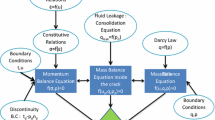Abstract
This paper examines the influence of plasticity in hydraulic fracturing. Fluid flow in the fracture is modelled by lubrication theory. Rock deformation is modelled by the Mohr–Coulomb flow theory of plasticity and the propagation criterion is based on the softening behaviour of rocks. The coupled, nonlinear problem is solved by a combined finite difference–finite element scheme. The results show that plastic yielding near the tip of a propagating fracture provides an effective shielding, resulting in an increase of the rock effective fracture toughness by more than an order of magnitude. Higher pressure is needed to propogate an elasto-plastic fracture than an elastic fracture, and the created elasto-plastic fracture is shorter and wider than the elastic fracture of the same volume.
Similar content being viewed by others
References
Barr, D.T. (1991). Leading-Edge Analysis for Correct Simulation of Interface Separation and Hydraulic Fracturing, PhD thesis, MIT.
Barenblatt, G.I. (1962). Mathematical theory of equilibrium cracks in brittle fracture. Advances in Applied Mechanics 7, 55–129.
Bazant, Z.P. (1986). Mechanics of distributed cracking. Applied Mechanics Review 39(5), 675–705.
Cleary, M.P., Wright, C.A. and Wright, T.B. (1991). Experimental and modelling evidence for major changes in hydraulic fracturing design and field procedures. Proceedings of the SPE Gas Technology Symposium, Houston, 131–146.
Chen, W.F. and Han, D.J. (1985). Plasticity for Structural Engineers, Springer-Verlag, New York.
Detournay, E. and Cheng, A.H.-D. (1991). Plane strain analysis of a stationary hydraulic fracture in a poroelastic medium. International Journal of Solids and Structures 37, 1645–1662.
Desroches, J., Detournay, E., Lenoach, B., Papanastasiou, P., Pearson, J.R.A., Thiercelin, M. and Cheng, A. (1994). The crack tip region in hydraulic fracturing. Proceedings of Royal Society London A 447, 39–48.
Desroches, J., Lenoach, B., Papanastasiou, P. and Thiercelin, M. (1993). On the modelling of near tip processes in hydraulic fracturing. International Journal of Rock Mechanics and Mining Sciences & Geomechanics Abstracts 30(7), 1127–1134.
Economides, M.J. and Nolte, K.G. (1989). Reservoir Stimulation, Prentice-Hall, Englewood Clift, N.J.
Hillerborg, A., Modeer, M. and Petersson, P.E. (1976). Analysis of crack formation and crack growth in concrete by means of fracture mechanics and finite elements. Cement and Concrete Research 6, 773–782.
Ingraffea, A.R. (1987). Theory of crack initiation and propagation in rock. Fracture Mechanics of Rock (Edited by B.K. Atkinson), Academic Press, London, 71–110.
Johnson, E. and Cleary, M.P. (1991). Implications of recent laboratory experimental results for hydraulic fractures. Proceedings of the Rocky Mountain Regional Meeting and Low-Permeability Reservoirs Symposium, Denver, 413–428.
Kanninen, M.F. and Popelar, C.H. (1985). Advanced Fracture Mechanics, Oxford University Press.
Lenoach, B. (1995). The crack tip solution for hydraulic fracturing in a permeable solid. Journal of Mechanics, Physics and Solids 43, 1025–1043.
Labuz, J.F., Shah, S.P. and Dowding, C.H. (1985). Experimental analysis of crack propagation in granite. International Journal of Rock Mechanics and Mining Sciences & Geomechanics Abstracts 22(2), 85–98.
Papanastasiou, P. and Thiercelin, M. (1993). Influence of inelastic rock behaviour in hydraulic fracturing. International Journal of Rock Mechanics and Mining Sciences & Geomechanics Abstracts 30(7), 1241–1247.
Rice, J.R. (1968). A path-independent integral and the approximate analysis of strain concentration by notches and cracks. Journal of Applied Mechanics, Transaction, ASME 35, 379–386.
Shlyapobersky, J. (1985). Energy analysis of hydraulic fracturing. Proc. of the 26th US Symposium on Rock Mechanics, Rapid City, 539–546.
Van den Hoek, P., Van den Berg, J. and Shlyapobersky, J. (1993). Theoretical and experimental investigation of rock dilatancy near the tip of a propagating hydraulic fracture. International Journal of Rock Mechanics and Mining Sciences & Geomechanics Abstracts 30(7), 1261–1264.
Wang, Y., Shen, S. and Cheng, H. (1994). Evolution of the plastic zone near a microfracture: a numerical simulation and its implications on the in situ stress measurement. Canadian Geotechnical Journal 31, 779–787.
Author information
Authors and Affiliations
Rights and permissions
About this article
Cite this article
Papanastasiou, P. The influence of plasticity in hydraulic fracturing. International Journal of Fracture 84, 61–79 (1997). https://doi.org/10.1023/A:1007336003057
Issue Date:
DOI: https://doi.org/10.1023/A:1007336003057




